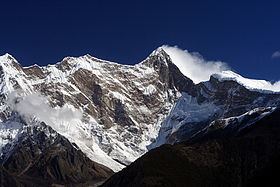Elevation 7,782 m Prominence 4,106 m | First ascent 1992 Listing Ultra-prominent peak | |
 | ||
Isolation 708 kilometres (440 mi) Easiest route SSW ridge on rock, snow and ice Parent ranges Himalayas, Namcha Barwa Himal Similar Mila Mountain, Mount Gongga, Gyala Peri, Mount Kailash, Gurla Mandhata | ||
Namcha Barwa or Namchabarwa (Tibetan: གནམས་ལྕགས་འབར་བ།, Wylie: Gnams lcags 'bar ba, ZYPY: Namjagbarwa; Chinese: 南迦巴瓦峰, Pinyin: Nánjiābāwǎ Fēng) is a mountain in the Tibetan Himalaya. The traditional definition of the Himalaya extending from the Indus River to the Brahmaputra would make it the eastern anchor of the entire mountain chain, and it is the highest peak of its own section as well as Earth's easternmost peak over 7,600 metres.
Contents
- Map of Namcha Barwa Mainling Nyingchi China
- Namcha barwa tibet grand canyon fly through tour google earth
- Location
- Notable features
- Climbing history
- References
Map of Namcha Barwa, Mainling, Nyingchi, China
Namcha barwa tibet grand canyon fly through tour google earth
Location
Namcha Barwa is in an isolated part of southeastern Tibet rarely visited by outsiders. It stands inside the Great Bend of the Yarlung Tsangpo River as the river enters its notable gorge across the Himalaya, emerging as the Siang and becoming the Brahmaputra. Namcha Barwa's sister peak Gyala Peri 7,294 metres rises across the gorge 22 km to the NNW.
Notable features
Namcha rises 5,000 to 6,800 metres above the Yarlung Tsangpo. After 7,795 metre Batura Sar in the Karakoram was climbed in 1976, Namcha Barwa became the highest unclimbed independent mountain in the world, until it was finally climbed in 1992.
In addition to being one of the highest mountains in the world, Namcha Barwa is also the third most prominent peak in the Himalayas after Mount Everest and Nanga Parbat.
Frank Kingdon-Ward described in the 1920s, "a quaint prophecy among the Kongbo Tibetans that Namche Barwa will one day fall into the Tsangpo gorge and block the river, which will then turn aside and flow over the Doshong La [pass]. This is recorded in a book by some fabulous person whose image may be seen in the little gompa [monastery] at Payi, in Pome. " (126-7)
Climbing history
Namcha Barwa was located in 1912 by British surveyors but the area remained virtually unvisited until Chinese alpinists began attempting the peak in the 1980s. Although they scouted multiple routes, they did not reach the summit. In 1990 a Chinese-Japanese expedition reconnoitered the peak. Another joint expedition reached 7460m in 1991 but lost member Hiroshi Onishi in an avalanche. The next year a third Chinese-Japanese expedition established six camps on the South Ridge over intermediate Nai Peng (7,043m) reaching the summit October 30. Eleven climbers climbed to the summit. U.K. Alpine Club's Himalayan Index lists no further ascents.
